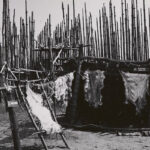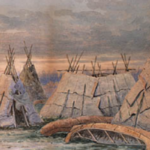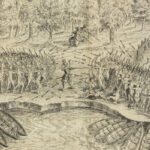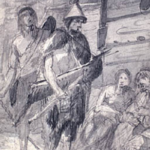The Haisla Nation: Stewards of the Kitlope and the Douglas Channel
The Haisla Nation, whose ancestral lands span the Kitlope Valley and the shores of the Douglas Channel in northern British Columbia, has thrived in this region for thousands of years. Known for their deep connection to the land and water, the Haisla have built a vibrant society rooted in sustainable resource management, cultural traditions, and maritime expertise. Despite the challenges posed by European contact and colonization, the Haisla have maintained their identity and traditions while asserting their rights and stewardship over their ancestral lands. Their story is one of resilience and cultural preservation.
Ancient Origins: People of the Kitlope
The Haisla people trace their origins to the Kitlope Valley, the largest unlogged temperate rainforest in the world, and the coastal waters of the Douglas Channel. Archaeological evidence, including village remains, fishing weirs, and artifacts such as stone tools and carvings, reveals that the Haisla have inhabited this region for over 9,000 years. The region’s abundant resources—salmon, shellfish, cedar, and game—allowed the Haisla to develop a sustainable and prosperous way of life.
The Kitlope, meaning “people of the rocks” in Haisla, is not only a source of sustenance but also a spiritual heartland for the Haisla people. Historian Cole Harris, in The Resettlement of British Columbia, observes, “The Kitlope Valley was more than a resource-rich environment for the Haisla; it was a cultural and spiritual cornerstone that defined their identity.”
Governance and Social Structure
The Haisla Nation is composed of two main clans: Kitamaat and Kitlope, each with distinct territories, responsibilities, and cultural traditions. Governance was conducted through hereditary leadership, with chiefs overseeing the management of resources, ceremonial practices, and intertribal relations. Decisions were made through consensus, emphasizing collaboration and reciprocity.
Potlatches were central to Haisla culture, serving as occasions for the distribution of wealth, the reinforcement of social bonds, and the performance of oral histories. These ceremonies also played a vital role in maintaining Haisla laws and traditions.
Marianne Ignace, in Keeping the Stories Alive, notes, “The potlatch was not only a cultural expression for the Haisla but also a vital institution for governance and the preservation of knowledge.”
Trade and Maritime Expertise
The Haisla were renowned for their maritime skills, navigating the Douglas Channel and surrounding coastal waters in cedar canoes. These canoes, capable of carrying people and goods over long distances, were essential for trade and cultural exchange. The Haisla traded fish, eulachon oil, and crafted goods with neighbouring nations, including the Tsimshian, Gitxsan, and Heiltsuk.
Bruce Miller, in Paths of the Coast, writes, “The Haisla’s maritime expertise and strategic location along key waterways made them integral players in the trade networks of the Pacific Northwest.”
First Contact with Europeans
The Haisla’s first recorded contact with Europeans occurred in the late 18th century, during maritime expeditions by European traders and explorers. Fur traders from the Hudson’s Bay Company and other companies quickly established relationships with the Haisla, exchanging goods such as furs, fish, and cedar for metal tools, textiles, and firearms.
While these early interactions brought new opportunities, they also introduced devastating diseases. Epidemics of smallpox, influenza, and measles swept through Haisla communities, drastically reducing their population. Bruce Trigger, in Indigenous Peoples of Canada, describes these epidemics as “a demographic catastrophe that reshaped the cultural and social dynamics of Indigenous nations.”
Colonization and Cultural Suppression
The 19th century brought increasing pressures on the Haisla as colonial governments established control over their lands and resources. Missionaries sought to suppress traditional practices such as the potlatch, while the establishment of Indian reserves under the Indian Act confined the Haisla to limited portions of their ancestral territories. The development of canneries and logging industries disrupted traditional fishing and resource management practices.
Despite these challenges, the Haisla resisted cultural assimilation. They continued to hold ceremonies in secret, practice traditional fishing techniques, and pass down their language and stories through oral traditions.
Historian Robin Fisher, in Contact and Conflict, notes, “The resilience of the Haisla in the face of colonial pressures highlights their determination to preserve their cultural identity.”
Cultural Revitalization and Advocacy
The 20th century marked a period of cultural revitalization for the Haisla Nation. Efforts to preserve the Haisla language and traditional practices became central to these initiatives. Language programs, cultural education, and the revival of ceremonies ensured that future generations remained connected to their heritage.
The Haisla have also been leaders in advocating for Indigenous rights and environmental protection. The Kitlope Heritage Conservancy, established in 1994, was the result of a groundbreaking agreement between the Haisla Nation and the Government of British Columbia, protecting over 320,000 hectares of pristine wilderness.
Margaret Conrad, in A Concise History of Canada, observes, “The Haisla’s leadership in protecting the Kitlope Valley reflects their deep connection to the land and their role as stewards of one of the world’s great temperate rainforests.”
Environmental Stewardship
The Haisla Nation has long been recognized for its commitment to environmental stewardship. Their traditional ecological knowledge has guided sustainable practices in fishing, forestry, and land management. The protection of the Kitlope Valley, a globally significant ecosystem, underscores their leadership in environmental conservation.
Cole Harris, in The Resettlement of British Columbia, writes, “The Haisla’s approach to land management reflects a profound understanding of the interconnectedness of ecological and cultural health.”
The Haisla Nation Today
Today, the Haisla Nation is a thriving community that balances traditional practices with modern opportunities for economic development, education, and governance. The Haisla have been actively involved in discussions around resource development in their territory, emphasizing the importance of sustainable practices and Indigenous consultation.
The Haisla Cultural Centre serves as a hub for preserving and sharing Haisla history, language, and traditions. Partnerships with local governments and organizations highlight the Haisla’s role as leaders in cultural revitalization and environmental stewardship.
A Legacy of Resilience
The history of the Haisla Nation is a testament to their enduring connection to the Kitlope Valley and the Douglas Channel. From their ancient stewardship of the land and water to their leadership in cultural revitalization and environmental advocacy, the Haisla have maintained their identity and place in northern British Columbia.
As Jean Barman writes in West Beyond the West, “The Haisla’s journey is one of continuity and renewal, a reflection of their strength and determination to preserve their place in the lands they have called home for millennia.”
References
- Barman, Jean. West Beyond the West: A History of British Columbia. University of Toronto Press, 1996.
- Carlson, Keith Thor. Living the River’s Legacy: The Fraser River and Coast Salish History. McGill-Queen’s University Press, 2011.
- Conrad, Margaret. A Concise History of Canada. Cambridge University Press, 2012.
- Fisher, Robin. Contact and Conflict: Indian-European Relations in British Columbia. UBC Press, 1997.
- Harris, Cole. The Resettlement of British Columbia: Essays on Colonialism and Geographical Change. UBC Press, 1997.
- Ignace, Marianne and Ronald E. Ignace. Keeping the Stories Alive: Language, Land, and Culture in Indigenous Communities. University of Toronto Press, 2008.
- Miller, Bruce Granville. Paths of the Coast: Trade and Diplomacy in the Coast Salish World. University of Washington Press, 2005.
- Trigger, Bruce G. Indigenous Peoples of Canada. McGill-Queen’s University Press, 1992.
- Kitlope Heritage Conservancy. Protecting the Heart of the Rainforest. Haisla Nation Council, 1994.
- Haisla Nation. Voices of the Kitlope: A History of the Haisla People. Haisla Cultural Centre Publications, 2005.



